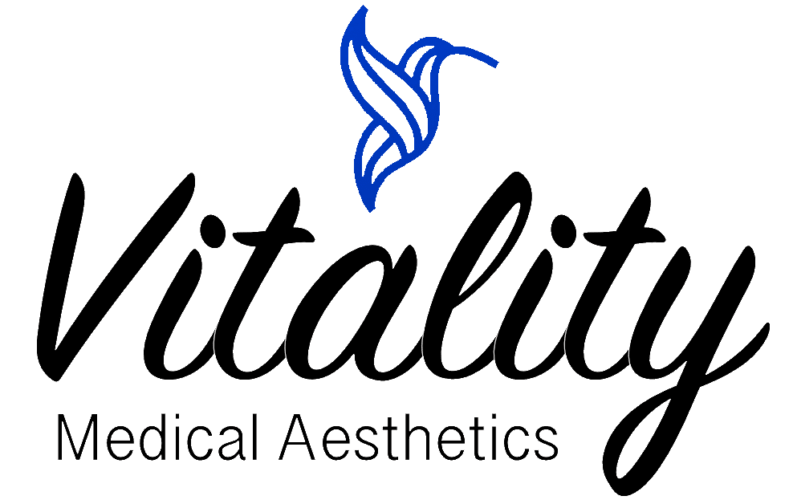
Chemical Peels
Chemical Peels in Orlando, FL
We provide brighter and clearer skin with our Orlando chemical peels at Vitality Aesthetics. Chemical peels help remove dead skin cells and stimulate skin cell turnover, stimulating your skin’s own healing power. Renowned for their remarkable ability to rejuvenate the skin, chemical peels offer a transformative solution addressing acne scars, sun damage, pigmentation, and an improved complexion.
Choose from a variety of chemical peels in Orlando designed to be safe and effective for all skin types to meet your specific treatment needs. The type of peel used can drastically affect results and downtime, so we provide a comprehensive consultation with our licensed medical providers make sure every is right for your type of skin and concerns.

What Are Chemical Peels?
Chemical peels offer a rejuvenating experience for your skin. They are specially formulated solutions to exfoliate the skin’s outer layers, resulting in increased collagen and elastin production, and a youthful, smoother appearance. The choice of chemical solution is tailored by our team to suit your specific needs. Chemical peels offer a range of options, from gentle peels that target surface-level imperfections to deeper peels for more significant skin concerns.
By eliminating damaged skin layers, chemical peels promote the regeneration of fresh, healthy skin, leading to a more even complexion, reduced signs of aging, and improved skin texture. Our medical spa uses AlumierMD chemical peels that are suitable for a wide range of skin concerns, regardless of whether you have oily, dry, or sensitive skin.
Your Skin Will Thank You.

@Vitality Aesthetics
Skin Concerns Helped By Chemical Peels
How Chemical Peels Work
Chemical peels enhance the texture and appearance of the skin through the controlled application of acidic chemical solutions. They are comprised of acids such as alpha hydroxy acids (AHAs), beta hydroxy acids (BHAs), or trichloroacetic acid (TCA), which are strategically applied to the skin to induce controlled exfoliation. Our peels are extracted from natural sources like sugar cane (glycolic acid), milk (lactic acid), and almonds (mandelic acid), these acids are instrumental in the peeling process.
The primary mechanism behind chemical peels lies in their ability to remove the outermost layer of damaged or dead skin cells, prompting cellular turnover and regeneration of new, healthier skin. The depth of the peel, categorized as superficial, medium, or deep, determines the extent of skin penetration and effects on skin concerns.
As the chemical solution is applied, it initiates a controlled wound-healing process, stimulating collagen production and promoting skin renewal. The peeling process that follows helps shed the damaged outer layers, revealing fresher, smoother skin underneath.
Additionally, the controlled injury induced by the peeling process encourages the production of new collagen and elastin fibers, contributing to improved skin elasticity and firmness. Ultimately, the comprehensive impact of chemical peels on skin health and appearance stems from their ability to promote cellular turnover, stimulate collagen synthesis, and address specific concerns based on the depth of the peel applied.

The Types of Chemical Peels
Superficial Peels
Also known as light peels, these use gentle alpha-hydroxy acids like glycolic or lactic acid to exfoliate the outermost skin layer. They are ideal for minor skin concerns, offering improvements in skin texture and complexion without significant downtime.
Medium Peels
These penetrate deeper into the skin and often feature trichloroacetic acid (TCA) or a combination of TCA and AHAs. Medium peels are effective for addressing moderate concerns such as acne scars, deeper wrinkles, and hyperpigmentation, but they require a longer recovery period.
Deep Peels
Our AlumierMD Chemical Peel Treatments
AlumierMD Radiant 30 Peel
A Great Overall Light Peel. The Most Popular Choice.
Radiant 30 stands out as an alpha hydroxy acid resurfacing peel enriched with lactic acid, designed to exfoliate dead skin cells, accelerate cell turnover, and promote collagen production. This versatile peel is crafted to address various skin concerns, such as fine lines, wrinkles, discoloration, sun damage, and enlarged pores. Its multifunctional nature makes it an excellent option for individuals new to peels or those with sensitive skin, offering a gentle yet effective solution for enhancing skin texture and tone.
AlumierMD BHA 20 Peel
A Light Peel For Acne and Congestion
BHA20 combines the benefits of salicylic acid and lactic acid for effective pore penetration and exfoliation. Salicylic acid dives into the pores, eliminating dead skin cells and excess sebum, while lactic acid exfoliates and hydrates the skin. The addition of eucalyptus contributes potent astringent properties. Together, this powerful blend works synergistically to promote smoother skin, minimize pore size, address acne concerns, and prevent the formation of new pimples.
AlumierMD Glow Peel
Medium Peel For Acne, Hyperpigmentation, Aging
The Glow Peel is a versatile resurfacing treatment featuring a blend of salicylic acid (7%), lactic acid (7%), resorcinol (7%), soy amino acids, and yeast-derived oligopeptide. This combination effectively targets signs of aging and hyperpigmentation with minimal downtime. Ideal for addressing concerns such as hyperpigmentation, fine lines, exfoliation, and overall rejuvenation, the Glow Peel offers comprehensive benefits for those seeking skin improvement.
AlumierMD Power Glow Peel
Deep Peel For Acne, Hyperpigmentation & Aging
The Power Glow features intensified quantities of the same ingredients found in the Glow Peel—14% salicylic acid, 14% lactic acid, and 14% resorcinol. This potent peel is designed to address various skin concerns, including fine lines, large pores, textural issues, pigmentation problems, and sun damage. An ideal choice for patients seeking to rejuvenate their skin and restore its natural brightness and glow. This is barely classified as a deep peel, but it gets
Preparing for a Chemical Peel in Orlando
- Skincare Consultation: Schedule a consultation with our experienced medical providers for chemical peels in Orlando. They will evaluate your skin, discuss your goals, and recommend the most suitable chemical peel.
- Follow Pre-Peel Instructions: Adhere to specific pre-peel instructions provided by our team, which may involve discontinuing certain skincare products and making necessary preparations to optimize your skin’s health.
- Protect Your Skin: Shield your skin from excessive sun exposure in the weeks leading up to your chemical peel. Use sunscreen, protective clothing, and avoid tanning beds.
- Avoid Certain Medications and Treatments: Inform your skincare professional about any medications, over-the-counter products, or previous cosmetic procedures you have used, as some may increase the risk of complications during a chemical peel.
- Maintain Hydration and a Healthy Lifestyle: Ensure you stay hydrated, maintain a balanced diet, and get enough rest in the days leading up to your chemical peel to support the healing process and enhance treatment results.
Understanding the Chemical Peel Process
A typical chemical peel procedure involves the following steps:
- Cleansing: Your skincare professional cleanses your face to remove dirt, oil, and makeup.
- Prepping: Depending on the peel type, a prepping solution may be applied to eliminate excess oil and prepare your skin.
- Application: The chemical peel solution is carefully applied to your skin using a brush or sponge, with the duration determined by your skincare professional.
- Neutralization: After a designated time, the chemical peel solution is neutralized, usually with water or a neutralizing solution to halt the exfoliation process.
- Soothing and Moisturizing: Following neutralization, a soothing mask or moisturizer may be applied to calm and hydrate your skin along with sunscreen.
The procedure typically takes 30 minutes to an hour, depending on the peel type and your skin’s specific needs. It’s normal to experience a slight tingling or stinging sensation, which typically subsides shortly after the peel is removed. Your skincare professional will provide comprehensive post-treatment care instructions.
Aftercare for Your Orlando Chemical Peel
Proper aftercare is essential for a smooth recovery and optimal results:
- Limit Sun Exposure: Protect your skin from sunlight by limiting sun exposure and using broad-spectrum sunscreen with SPF 30 or higher, along with protective clothing.
- Avoid Picking or Scratching: Refrain from picking or scratching any peeling or flaking skin to prevent scarring or infection.
- Moisturize: Keep your skin hydrated with a gentle, non-irritating moisturizer as instructed by your skincare professional to soothe dryness and discomfort.
- Avoid Harsh Skincare Products: In the days after a chemical peel, steer clear of harsh products like exfoliants or retinol, opting for gentle, non-abrasive cleansers and moisturizers recommended by your skincare professional.
- Be Patient: Results may take several weeks to become apparent. Allow your skin time to heal and regenerate, and follow post-treatment instructions provided by your skincare professional.
Medical Grade
Orlando Chemical Peels
At Vitality Medical Aesthetics, our team comprises highly qualified and seasoned advanced practice providers like Stephanie Mirksy, PA-C with Florida medical licensure as a NCCPA board certified Physician Associate and advanced cosmetic injector. Though uncommon, chemical peels can have potential complications that highlight the importance of choosing a facility with skilled professionals capable of making clinical decisions and adhering to appropriate evaluation and treatment protocols.
Orlando Chemical Peel Questions Answered
Chemical Peels Orlando, FL @ Vitality Aesthetics
Vitality Aesthetics is a medical spa conveniently located to serve Orlando, Winter Park, and greater Central Florida.
We’re obsessed with getting results for patients. Schedule a consultation and find out how we can help you.
